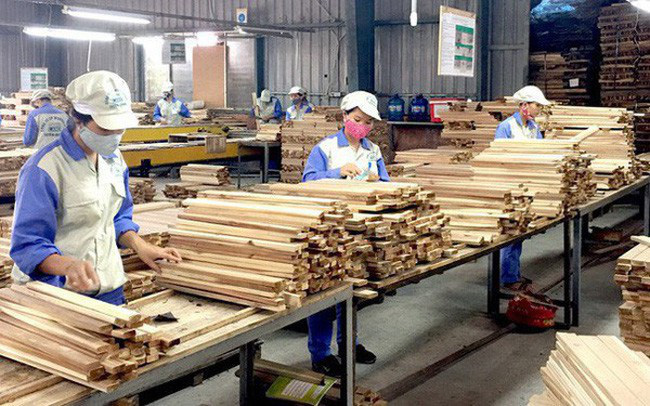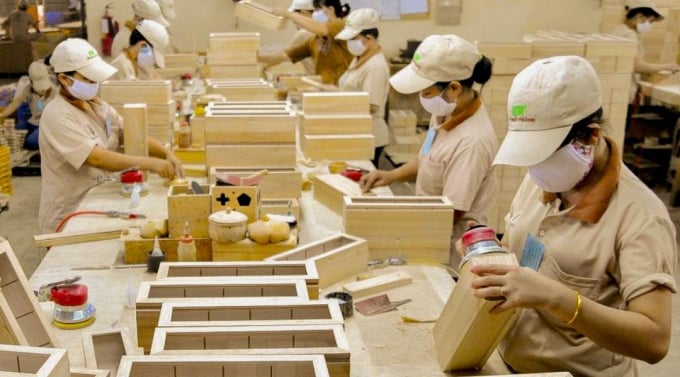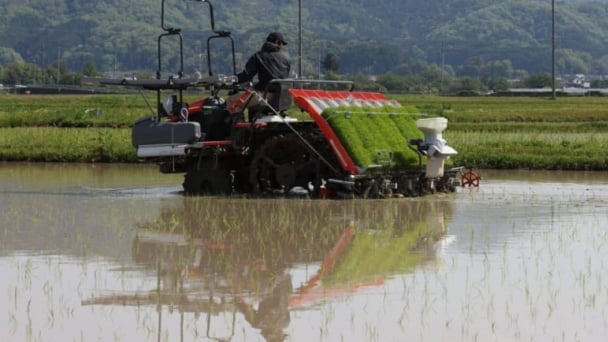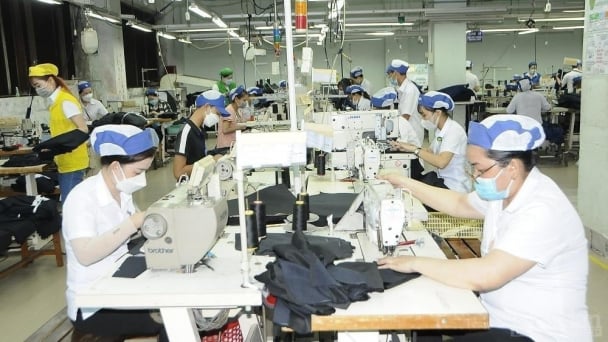May 14, 2025 | 21:00 GMT +7
May 14, 2025 | 21:00 GMT +7
Hotline: 0913.378.918
May 14, 2025 | 21:00 GMT +7
Hotline: 0913.378.918
At the Wood Industry Briefings for the third quarter of 2022 in Dong Nai, Deputy Minister of Agriculture and Rural Development Le Quoc Doanh shared about challenges currently facing the wood industry. He also pointed out two factors that have caused the number of purchasing orders in the wood industry to decrease recently, namely the high price of production materials and products as well as the increasingly strict credit policies in countries due to rising inflation; this in turn has led to a sharp drop in consumer demand.

Deputy Minister Le Quoc Doanh sympathizes with the current difficulties of businesses in the wood industry.
According to Deputy Minister Le Quoc Doanh, the export of wooden products to the US market in the
Mr. To Xuan Phuc, a policy analyst of Forest Trends, suggested management agencies to have direct and timely support policies. This is due to the fact that out of 52 businesses surveyed by Forest Trends, approximately 19% of whom reported that they could only hold out for less than 3 months, 44% could hold out for 3 to 6 months and 23% could hold out for more than 12 months.
first 7 months of the year reached approximately 5.84 billion USD, which is a decrease of 4.9% over the same period in 2021. This has rendered the export value of wooden and timber products in the first 7 months of 2022 to be estimated at 10.42 billion USD, an increase of only 1.3% compared to the same period in 2021, which is a lower rise compared to last year.
The US Federal Reserve (FED) has recently increased the basic interest rate by 0.75% to an interest rate of 2.5%. Deputy Minister Le Quoc Doanh analyzed this motion as: "We need to properly assess the situation. This is current state of the world. Domestic wood businesses need to stabilize and thoroughly identify each factor."
As an industry whose output is mainly for export, the wood industry is guided by a number of key tasks as assigned by the leaders of the Ministry of Agriculture and Rural Development for the second half of 2022.
Regarding businesses, Deputy Minister Le Quoc Doanh suggested them to strengthen trade promotion activities, actively explore key markets. According to the General Department of Forestry, the US, Japan, China, EU and Korea are the main export markets, with export value accounting for 90% of Vietnam's total export value.

The wood industry is facing many difficulties in exporting products.
In addition, businesses need to produce in a more methodical and fundamental manner to help reduce costs and increase competitiveness in the market. On the other hand, they need to also improve the quality and skills of their workers, promote digital transformation, and develop e-commerce.
"Wood industry businesses need to share and help one another with information about the market and technology now more than ever, to contribute to improving the overall strength of Vietnam's wood industry", emphasized Deputy Minister Le Quoc Doanh.
Deputy Minister Le Quoc Doanh requested management agencies, including the General Department of Forestry, to closely coordinate with the Department of Trade Remedies (Ministry of Industry and Trade) to thoroughly handle anti-dumping cases in the markets of the importing countries.
After receiving the suggestions from Deputy Minister Le Quoc Doanh, Mr. Vo Van Phi, Vice Chairman of Dong Nai Provincial People's Committee held that the province will accompany businesses operating in the wood industry to solve "unprecedented difficulties" such as: Reduced, delayed, canceled or no production orders; unemployed workers; difficult financial situation regarding taxes, fees and debt collection.
After listening to the comments, Deputy Minister Le Quoc Doanh said that the market tends to be a sine wave. To overcome these immediate difficulties, businesses need to expand their markets as well as their export products. This is also a solution for businesses to survive the economic recession and seize opportunities as soon as the market recovers.

Vietnam's wood export target in 2022 is 16.3 billion USD.
Nearly 71% of businesses surveyed by the Vietnam Timber and Forest Product Association said that the number of orders from now until the end of the year will continue to decline.
Citing a recent survey on 52 businesses carried out by the Wood Associations in coordination with Forest Trends, Mr. Do Xuan Lap - Chairman of the Vietnam Timber and Forest Products Association (VIFOREST) - said that 33 out of 45 businesses exporting to the US; 24 out of 38 businesses exporting to the EU and 17 out of 25 businesses exporting to the UK had a nearly 40% drop in revenue compared to the first few months of the year.
There are very few businesses with a positive growth in revenue, according to Mr. Lap. In addition, at least 71% of the surveyed businesses believe that orders for wooden products will continue to decrease towards the end of the year. 44% of businesses reported that their revenue for the entirety of 2022 will decrease by approximately 44% .
"Businesses in the wood industry are currently facing many difficulties in terms of capital, labor costs and input materials", analyzed Mr. Lap.
Mr. Lap elaborated on the circumstances: "Inflation rate is high in major markets such as the US, Europe, UK among others. The critical inflation levels are negatively affecting the production and business activities of businesses in the wood industry. Most of whom are facing various difficulties in terms of capital, labor costs and input materials.
To combat these difficulties, many businesses reduced their production scale, changed products, and transformed the markets. These factors will affect the wood industry's target of 16.3 billion USD in wood exports by the end of 2022.
Sharing more on the wood export target for 2022, Mr. Bui Chinh Nghia, Deputy Director of the General Department of Forestry said that export growth in the first 7 months of 2022 was low compared to the same period in 2021 as well as the previous years.
Namely, for the first 7 months of the year, export value of wooden and timber products was estimated at 10.42 billion USD, which is an increase of 1.3% over the same period in 2021.
According to Mr. Nghia, the cause of the problem lies in the main export market (the US), which decreased by 4.9% due to their increasingly strict credit policy to control inflation. The consumer demand in this market was subsequently dragged down, causing the overall growth rate of the entire industry fail expectations; although exports to Japan, Korea, and China had a positive growth of 13% due to the growing export of wood chips and wood pellets.
Another reason for the stagnation of the wood industry is the high prices of raw materials and products. The costs for production materials and transportation all rose sharply.
However, leaders of the General Department of Forestry are optimistic about the supply of raw materials from domestically planted forests. Mr. Nghia believes that the domestic wood supply can generally meet production needs.
In addition to the commitment to organize the Workshop on Investment Promotion of Wood and Timber Products Processing in the Northern Upland Provinces and the Workshop on Promoting Wood Brands in the South, the General Department of Forestry warned about the risk of wood materials shortage. This is due to the fact that the rising demand for production of wood chips and pellets, which leads to an increase in purchasing prices and the tendency of forest owners to cut down young (3 to 4 years old) forests.
VIFOREST proposed the banking sector to adopt preferential policies for wood industry businesses to overcome the current difficult period including debt extension, due loans extension, inventory loans, etc. Additionally, the Association proposed the Ministry of Finance to adopt policies on tax and fee support such as reduction and delay in corporate income tax collection; land rent reduction; timely VAT refund to pay the capital for businesses.
Translated by Nguyen Hai Long

(VAN) Japan's efforts to lower the price of rice through the release of its stockpile may finally be making some progress, albeit at a snail's pace.

(VAN) U.S. tariffs are not only a 'shock', but also an opportunity for Vietnamese businesses to renew their mindset toward comprehensive development.

(VAN) As Bac Giang lychee enters the harvest season, Minister Do Duc Duy expects that the fruit will contribute greatly to agricultural exports due to standardized production and deep processing.

(VAN) Consumers have shown a preference for free-range eggs, but those farming systems are more vulnerable to biosecurity risks like bird flu.
/2025/05/09/5701-1-184335_301.jpg)
(VAN) Vietnam’s eel exports nearly doubled thanks to a mud-free farming model, opening up new prospects while still facing numerous barriers related to international standards.

(VAN) Minister Do Duc Duy warned that if production is not professionalized and supply chains are not transparent, the U.S. market could become a growth bottleneck.

(VAN) Delegating surveillance responsibilities to local authorities is a cost-saving and efficiency-boosting measure that removes a key bottleneck for enterprises, according to Director General Duong Tat Thang.